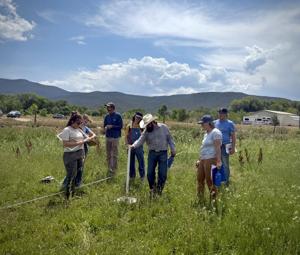Taos, New Mexico, has been chosen as one of only two locations in the United States for a significant citizen science initiative focused on regenerative agriculture. This selection comes as part of the Ecdysis Foundation’s “Project Avalanche,” aimed at empowering farmers and ranchers to adopt sustainable practices. The foundation’s research project will enable participants to monitor and enhance soil health, biodiversity, and crop productivity.
The initiative traces its roots to an outdoor screening of the documentary Kiss the Ground on Earth Day 2020, which emphasized the importance of soil health. Gillian Joyce, the executive director of Alianza Agri-Cultura de Taos, recalls the event as a pivotal moment for agricultural collaboration in the region. Amid the challenges of a cold day, approximately 50 attendees gathered to discuss the future of farming, setting in motion a movement toward regenerative practices in the community.
John Lundgren, founder of the Ecdysis Foundation and a former employee of the U.S. Department of Agriculture, highlighted the urgency of adapting agricultural methods to the rapidly changing environment. He stated, “The world is just changing around us really fast.” The foundation aims to identify successful practices through Project Avalanche, which builds upon its previous Thousand Farms Initiative, where research has been conducted on over 1,600 farms in more than 30 states and two Canadian provinces.
The Ecdysis Foundation has invested $7,500 per farm into the project, but it remains free for participating farmers. “We will do our best to keep it that way,” Lundgren noted in a recent communication. The program focuses on equipping local farmers with the tools needed to assess soil metrics and track biodiversity.
In August 2023, Taos farmers, including Robert Martinez Sr., who operates a grass-fed cattle business, participated in a training session conducted by Ecdysis staff. They learned how to sample soil for critical indicators such as temperature, density, and compaction. Martinez described the experience as foundational, comparing the initial metrics to a test that assesses where one stands in their agricultural journey.
With an increasing demand for organic produce, Martinez believes that smaller producers can thrive despite the challenges posed by the region’s short growing seasons. “Those of us that are continuing, we’re trying to do a better job. We’re trying to improve our soils,” he said.
Lundgren’s journey into regenerative farming began after more than a decade at the USDA, where he felt systemic change was necessary to combat climate issues. “I quit ten years ago; I quite literally bought the farm,” he explained. He now runs his own sustainable operation, growing lamb, poultry, and various crops while advocating for regenerative practices.
The Ecdysis team, including lab manager Kristianna Gehant Siddens, is dedicated to fostering relationships between farmers and consumers. Siddens emphasized the need for farmers to have a strong sense of purpose and identity when adopting new practices. “It can help affirm to farmers putting in the work that it’s paying off,” she noted, referring to the importance of tracking metrics.
Despite the ongoing challenges of drought affecting the region, Taos farmers are optimistic about the future. Martinez expressed a commitment to learning and adapting, stating, “There’s a huge learning curve, and I’m in the midst of it. I know I’ve got a whole lot to learn.”
As Taos takes this crucial step towards sustainable agriculture, the community stands ready to embrace new practices that promise environmental and economic benefits, not just for themselves, but for the broader food system.
